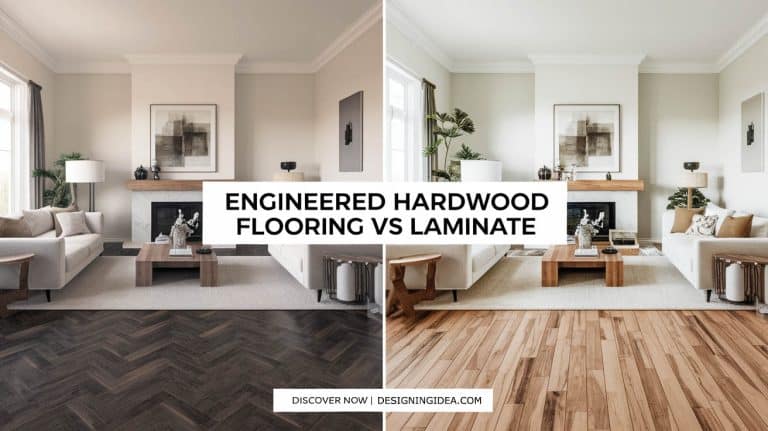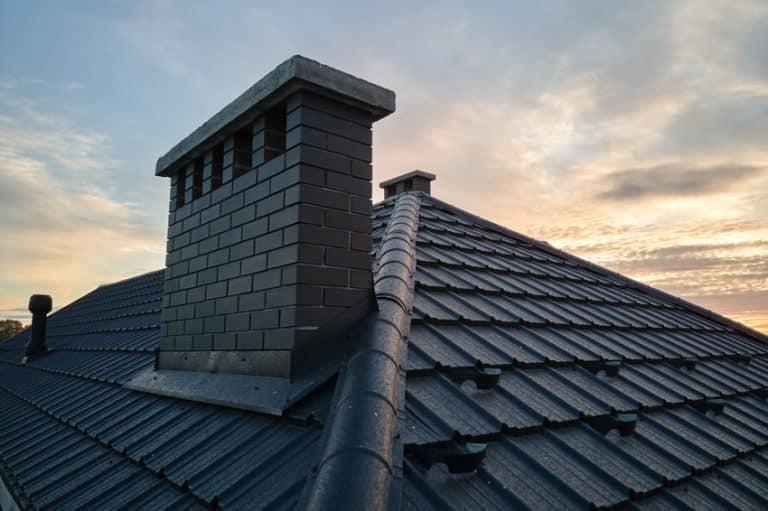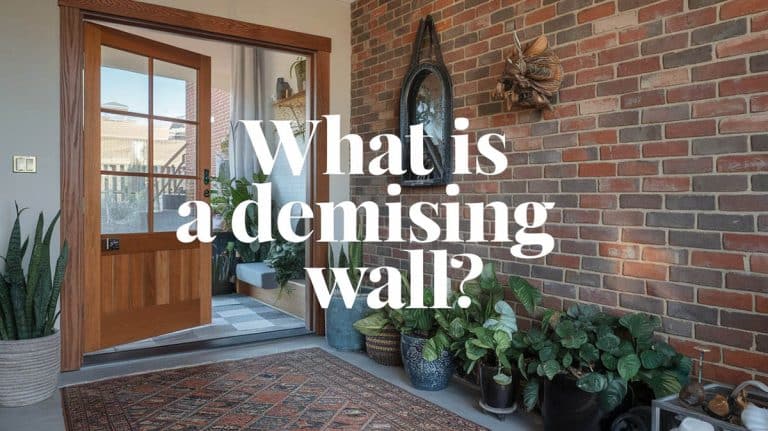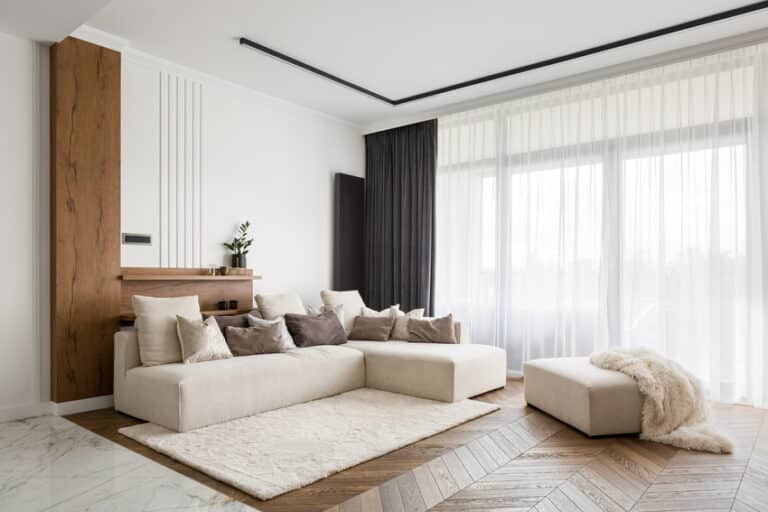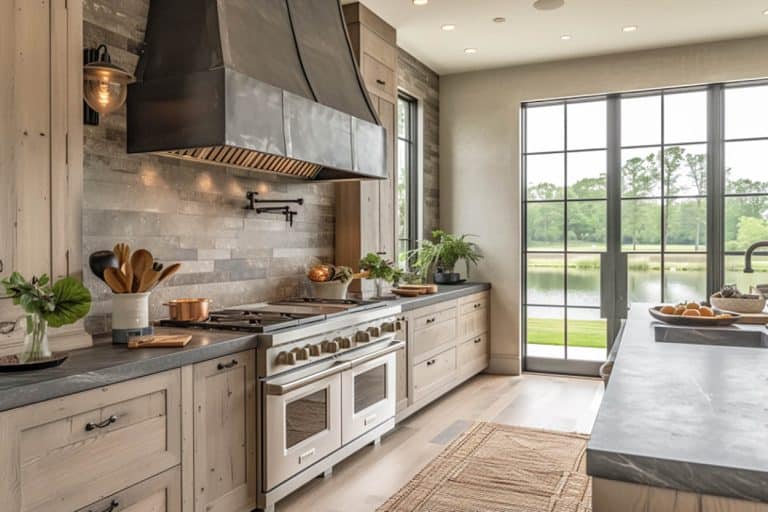9 Types of Drywall For Your Home (Uses, Sizes & Tools)
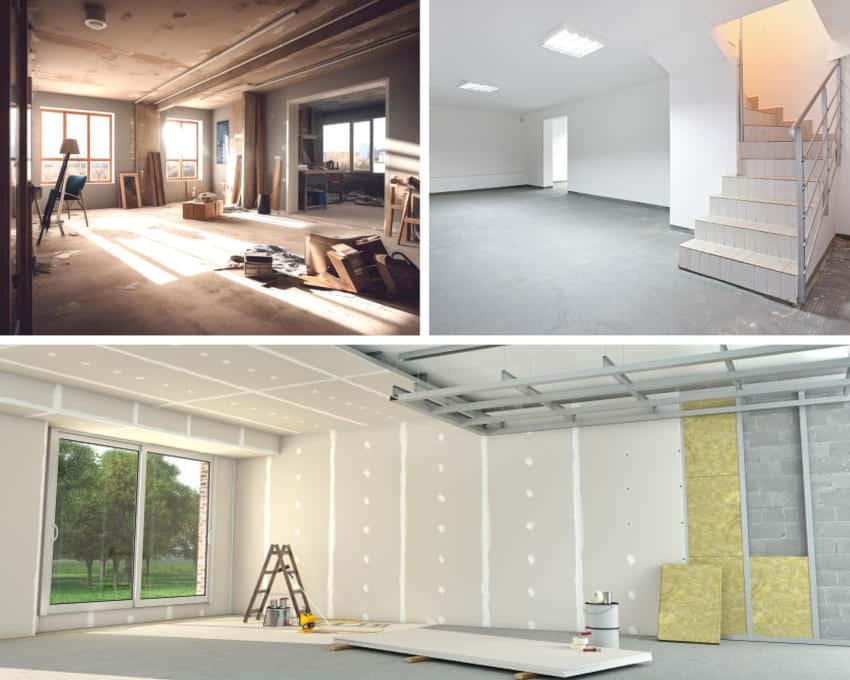
Several decades ago, many homeowners used sheathing and plaster for their wall coverings. As time went by, people developed a new product that became available in the market to promote a quicker way to finish walls and ceilings – drywall. It is now the most common finishing material for interior walls and ceilings.
One of its significant benefits is the inclusion of trimmed edges on the long side of drywall sheets. When connected, create a shallow recess for tape and joint compound, allowing undetectable finished joints.
Drywall is a multifunctional construction material that can be used to construct or conceal ceilings and walls. It comes in a diverse array of structures and types.
However, what are the various types of drywall? Let us discuss this question in more detail in this article. We will also provide you with all the important information about it, too.
Quicklist: Different Types of Drywall
- Regular
- Mold-Resistant
- Moisture-Resistant
- Veneer Plaster
- Paperless
- Environmentally-Friendly
- VOC-Absorbing
- Fire-Resistant
- Soundproof
What Is Drywall Used For?
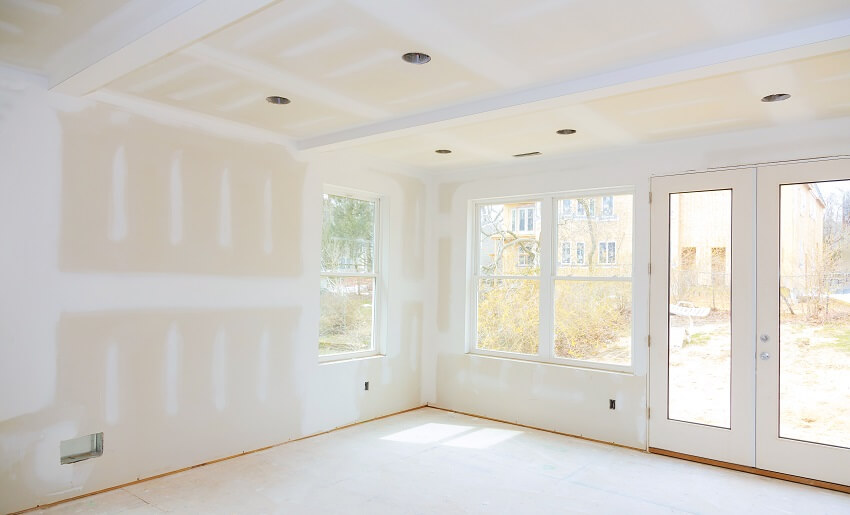
Drywall is a type of construction material that is utilized to protect the framing on ceilings and walls. It is generally made out of gypsum, a naturally recurrent mineral abundant in production, making it an environmentally friendly selection.
The gypsum is combined with other materials to form a slurry, which is then wedged between two layers of paper and left to dry. The paper type and thickness and the substances in the slurry determine the type of gypsum board.
Furthermore, it pertains to the sizable, rectangular sheets that could be found layered in shops and on construction projects. It normally comes in white, green, blue, and purple. It is a basic element of your house, office, or store where you make purchases and nearly every finished structure’s interior.
When you look at your ceilings and walls, you will notice that they are made of plaster wall installed over wood studs. It has been finished, patterned, painted, or plastered. However, the walls and ceilings are dry panel.
Such construction element serves a purpose other than wall and ceiling construction. Aside from its primary purpose, it is often used to bring aesthetics by covering small cracks in building and house interiors.
Regular Drywall
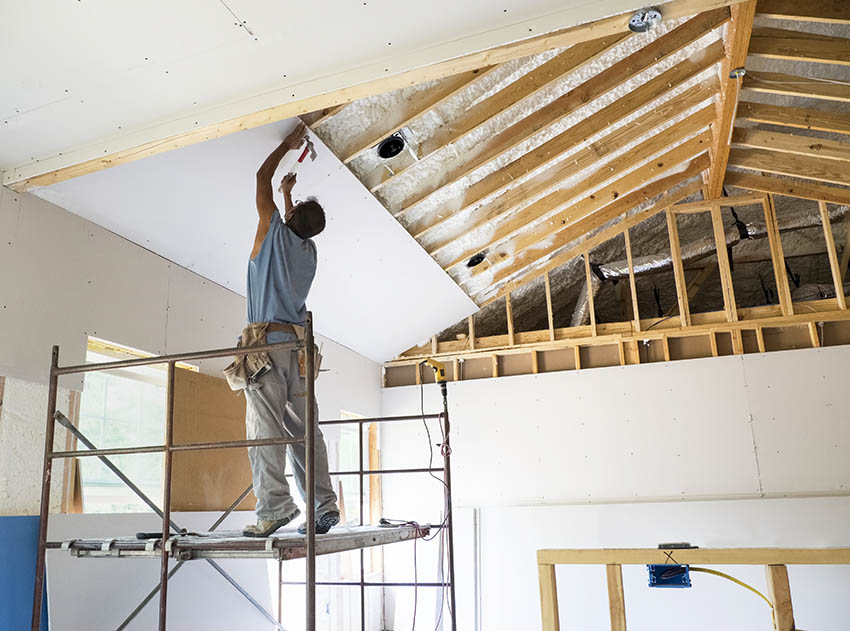
This is the most popular type of plaster board, usually applied in ceilings and walls in houses and business developments. It has no unique features. It is not weaker than other types; it performs on par. It simply does not have any additional features.
Customarily, it is white on one side and brown on another. It is the most cost-effective type and is available in various thicknesses around 0.4 inches to 1 inch. This is typically available in 4 by 8 feet panels.
Mold-Resistant Drywall
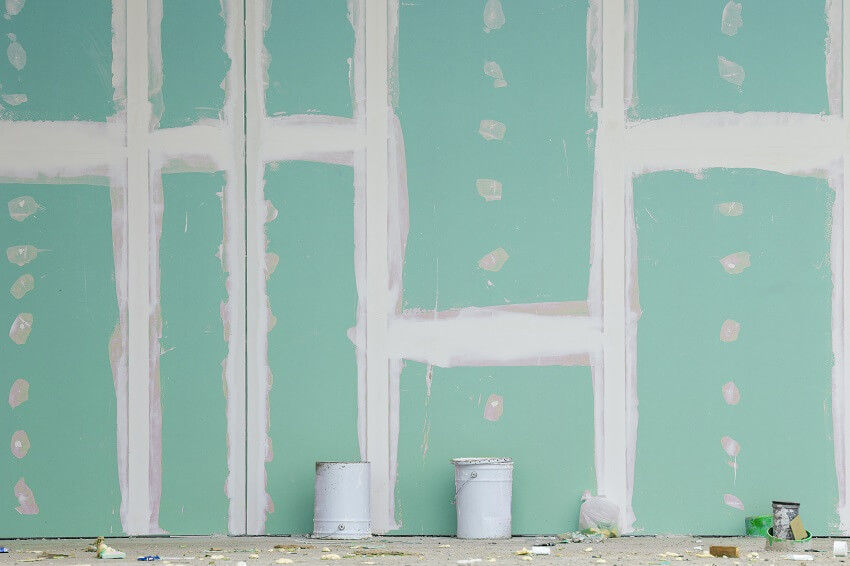
Mold-resistant gypsum panel, also known as purple board, is constructed with a denser paper-made backing than standard type and is wax-coated for additional moisture resistance. Moreover, it includes a non-organic fiberglass mesh that removes any substances that might trigger mold growth.
Mold-resistant type is commonly used in bathrooms, kitchens, and laundry areas and as a tile supporter. There is also a mold-resistant variant. It is significant to mention that moisture-resistant wallboard is different from mold-resistant one.
This treated version may be worth considering if you live in a high-moisture area. It is more expensive than the regular type. However, if mold and mildew are disturbing and could cause serious health issues, you can undoubtedly find that added cost beneficial.
Moisture-Resistant Drywall
Moisture damage persistently occurs. It is indeed an almost-unavoidable part of owning a home. Fortunately, a moisture-resistant type of plasterboard offers a specialized surface coating that reduces the severity of moisture damage when it occurs.
Green dry panel, offers powerful moisture-resistant attributes. It is ideal for restrooms, kitchens, and humid or water-piped environments.
A cement board should be used instead of a moisture-resistant board in high-moisture locations, including bathtubs and showers. This type is also known as an indoor-tile backer board and cement board.
Veneer Plaster Drywall
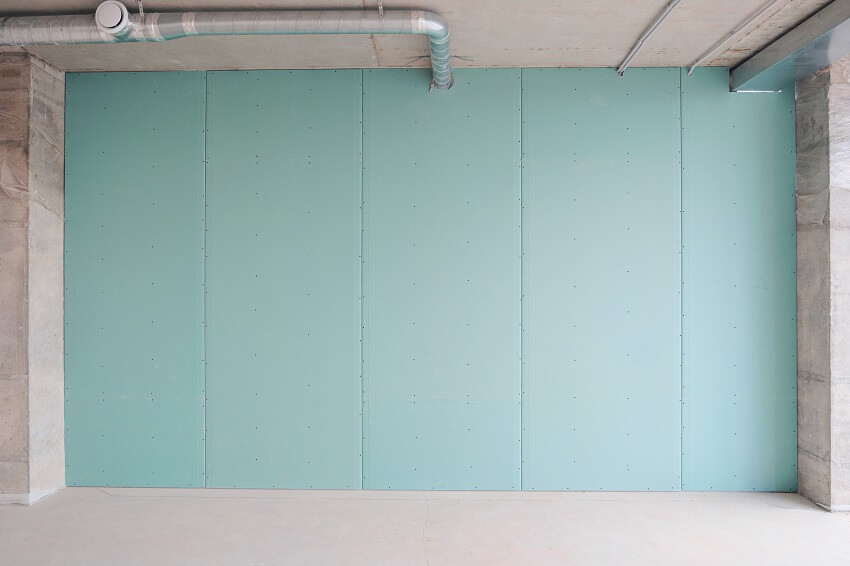
A veneer plaster is a form of plaster that is adhered to a surface known as a substrate. It is most typically utilized for a specially prepared gypsum board base comparable to regular dry wall panel.
Veneer plaster necessitates the application of a thin coat or layers of plaster over the whole surface. Because the face paper is absorbent, the plaster finish coat adheres to the plasterboard better.
Plaster veneer is excellent for updating old houses with lath-and-plaster walls. It is a lot simpler, cost-effective, and quicker to put veneer plaster over damaged walls than to tear those walls out and replace them with regular dry panel.
You may come across the term “blue board.” This unique item is designed to be coated with a veneer plaster to give it a distinctive appearance. Aside from that, plaster veneer is frequently applied in old houses, and you can find experts skilled at installing it.
Paperless Drywall
Paperless dry panel has largely substituted paper type. This variant is coated with fiberglass rather than paper, safeguarding the gypsum board from decay and providing even greater mildew tolerance.
The board’s efficiency is slightly higher than the regular one, but some structural engineers find it much easier to trim. This variety is impervious to both moisture and fungus.
Unlike other types of gypsum boards, the paperless kind is protected with fiberglass veneers. This is a possibility for your bathrooms and kitchens.
Additionally, this kind offers minor styles requiring a joint substance for a seamless, clean finish quality.
Environmentally Friendly Drywall
Environmentally friendly gypsum boards have been created and are still being produced nowadays. Such products are not only environmentally friendly in terms of components and manufacturing processes, but they are also high-quality options for your home, making them more valuable and long-lasting.
You can find models that are purely made from eco-friendly materials. Waste fibers from agricultural production, the newspaper business, and other industries are compressed into sturdy concrete-like panels that serve as household and building ceilings and walls.
VOC-Absorbing Wall Sheeting
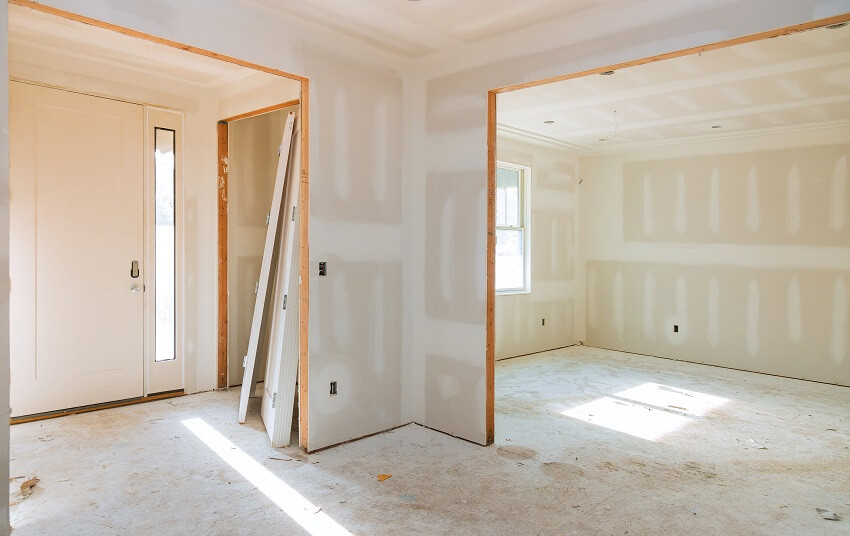
This unique type, called VOC-absorbing, is a slightly new product in the market. It encompasses chemical substances and certain volatile organic compounds (VOCs) and snares them inside the dry wall panel, making them inert.
Inhaling VOCs over long periods can increase the risk of health issues, especially those asthmatic children and the elderly. Other health problems from prolonged VOC inhalation include central nervous system damage and cancer. [Source: Minnesota Department of Health]
Such chemicals are derived from other construction materials and cleaning supplies we use daily. This type of wall material can be painted or covered by soft wallcovering for up to 7 decades.
Fire-Resistant Drywall
Advanced fire-resistant plaster wall is utilized around potentially flammable equipment in garages and basements. Building codes require fire-resistant materials such as Type X, fireboard, or X board in garages, bedrooms, apartment complexes, multi-family residential units, and other commercial structures.
Type X is created from fire-resistant fibers. It is typically 5/8-inch thick, and the extended thickness can enhance its sound-absorbing properties.
Fiberglass is used in fire-resistant dry wall and does not burn as quickly as standard gypsum. Type X outperforms other variants in terms of fire tolerance. However, type C is more resilient than Type X, offering up to 4 hours of resistance versus Type X’s 1 hour.
Specialized non-combustible fibers are used in fire-resistant type. It is also denser than the majority of other forms. Such features, when combined, delay the burning and dispersion of fire, giving homeowners more time to evacuate and reduce the degree of destruction.
Soundproof Drywall
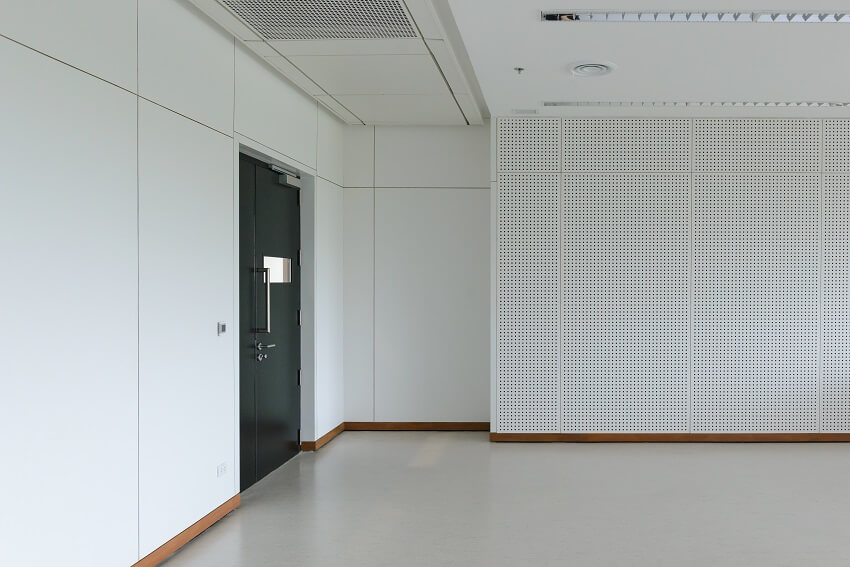
Soundproof dry panel is similar to standard plasterboard but is laminated and consists of multiple layers of fiberboard, gypsum, and polymeric materials to help lessen sound and increase the sound transmission class (STC).
Its structure makes it firmer than standard type, reducing sound vibrations. This is utilized in the construction of walls, ceilings, or floors.
Since this type is thicker than the standard variety, it may be more difficult to cut than other dry panel. It is applied in areas where noise is an issue or when silence is needed in a room owing to its soundproofing properties.
Drywall Color Code
• Green board. The board has a green coating that makes it more moisture-resistant than the standard type. It is slightly more costly, but remember that it is not fully waterproof, so do not use it if it comes into contact with water.
• Blue board. This color code is also recognized as a plaster baseboard. A blue board is utilized for veneer plasterboard, and the surface paper has distinctive absorption properties. It is highly resistant to moisture and mold, and there are very few key steps in veneer plastering. Blue board dry board is not intended for mud, tape, or paint use.
• Purple board. This provides the same benefits as standard gyp board but with outstanding moisture, mildew, and mold resistance. It can be utilized in all wall and ceiling uses and is suitable for areas that require increased water and mold resistance.
Drywall Dimensions
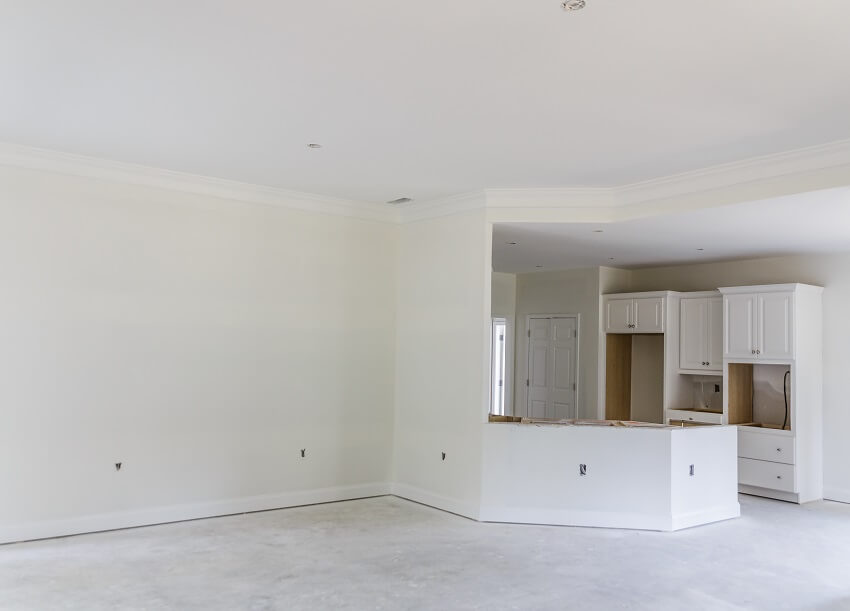
Drywall is normally measured in length and thickness. The standard thickness of drywall panels is 1/2 inch. Itcomes in a variety of lengths. Sheets are available in lengths of 8, 9, 10, 12, and 14 inches. Other lengths are occasionally available as a custom layout.
Thickness is a significant measurement. 4 depth options allow you to select the size that best suits your needs. It is available in 4 thicknesses:
• 1/4 inch. Even though standard gypsum wall is available in this size, panels this thin are unusual.
• 3/8 inch. This width is obtainable in standard kind. It is prevalent in basements and other areas where a specific form for drywalls is not required. Although less costly than denser panels, it is also less durable.
• 1/2 inch. Half-inch wallboard is bulkier than the two preceding measurements. Standard, moisture-resistant, and mold-resistant options are obtainable at a depth of 1/2 inch.
• 5/8 inch. This is the thickest type obtainable. This thickness is available in all kinds of sheetrock, but it is most beneficial in fire-resistant, soundproof, moisture, and mold-resistant boards.
When looking for plasterboard, you may come across the phrase “standard size.” This pertains to a sheet that measures 1/2″ x 4′ x 8′. This is a popular size, especially among do-it-yourselfers, since it is inexpensive, adaptable, and easy to manage.
Drywall Materials
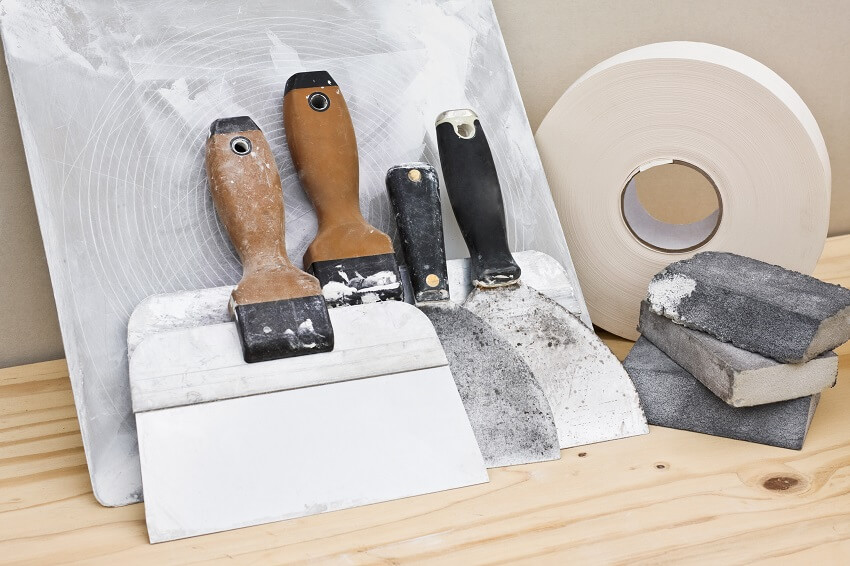
To turn your dream home into reality, you must apply wallboard. However, you will need drywall-specific materials and tools to accomplish this.
Crucial materials will be required when installing such material to your home. We have emphasized the most important ones below:
Fasteners
Fasteners are accessories that hold the panels to the boards of the ceilings and walls. Construction workers, carpenters, and do-it-yourselfers employ nails, screws, or sometimes both.
Screws are more costly than nails. However, they are more reliable and will stay firm as the timber ages. Nails will eventually protrude from the wood and appear as a nudge in the wall called nail pops. Nails, on the other hand, are simpler to work with and can be used quicker than screws.
Several individuals prefer to use screws as well as nails. They use nails around the outside edges and in the edges to secure the metal strips known as beads. Plus, they use screws in every other part of the house, including the ceiling.
Corner Bead
Every edge has a corner bead to guarantee a clean 90-degree angle. Tape is then adhered over the beads, followed by the joint compound. Corners would be irregular and untidy without the beads.
Drywall Joint Compound
A joint compound, also known as mud or spackle, is a substance that is adhered to over tape to balance out seams. You will also use it to conceal the nails and screws. It comes pre-made in buckets.
Tape
Tape is used to conceal the seams between sheetrock segments. There are two kinds of tapes for drywalls: paper and mesh.
Paper is less expensive than mesh and wrinkled down the center to make taping edges easier. Mesh is excellent for major repairs.
Drywall Tools Checklist
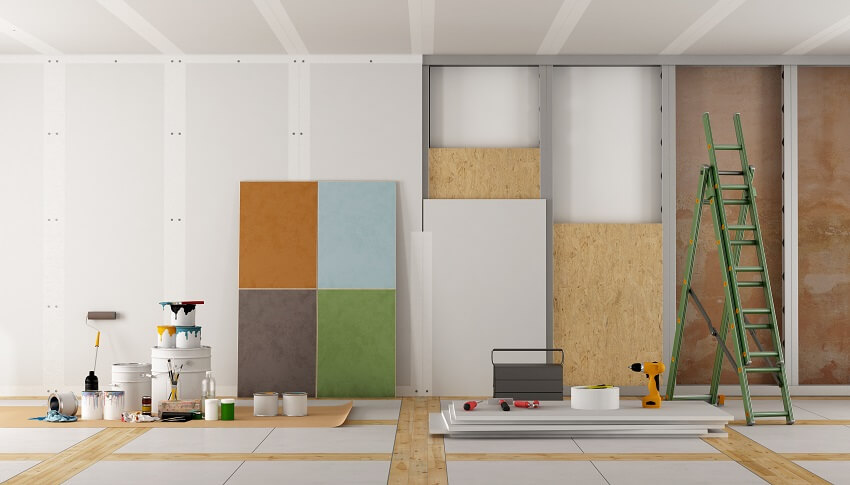
Every construction project has its own set of tools. Proper sheetrock tools will make your project much simpler and more rewarding. We have compiled a list of some of the most useful tools available to help you get started:
Pencil
A pencil is among the most valuable tools for you will be measuring and marking a lot, so a pencil is necessary for the entire process.
Drywall Hammer
If you are going to use nails rather than or in addition to screws, this specialized hammer has a rounded head to prevent impacting or breaking the sheetrock.
Even if your original plan is to utilize screws throughout the construction process, having a specialized hammer on hand is a smart idea if you decide that nails are necessary for locations like the exterior areas of a panel.
Framing Square
A plasterboard project requires the use of a framing square. Using this simple device when trimming sheetrock ascertains precise measurements and clean lines.
Hand Sander
Upon adding the joint compound and allowing it to dry, the compound should be sanded to remove lines and start making the compound flush with the drywall. As a result, the wall or ceiling would be flat and smooth.
On the front of the hand sander, sheets of sandpaper, or wallboard sanding surface, are positioned. The said surface is available in sheets. When one sheet is no longer functional, replace it with the hand sander and continue performing the process.
Automatic Drywall Sanding Device
Manual sanding offers a sense of thorough supervision as you construct your space, but it can also be exhausting and time-consuming. You can intersperse between manual and automatic sanding or go completely automatic.
Automatic sanding devices are available in both cordless and corded versions. Cordless power devices, like other power equipment, deliver ease and convenience of mobility, while corded variants offer greater power with no major disruptions. Both versions use the same sanding screen that hand sanders do.
Numerous automatic plasterboard sanders are attachment-compatible. Sanders are commonly equipped with circular and triangular heads, allowing you to conveniently sand both edges and flat stretches of walls and ceiling.
Trowel or Drywall Knife
Drywall knives or trowels will apply and distribute the joint compound. They are available in many widths appropriate for various areas of paneling. You can use a broader blade in lengthy, open spaces and slimmer blades in narrow spaces to expedite the work.
Drywall Screw Gun or Cordless Screwdriver
As you attach the plasterboard to the ceiling or wallboards, you will be driving numerous screws into it. Hence a cordless, battery-powered screwdriver is extremely important. It will speed up and improve the accuracy of your work.
You could use a drill rather than a cordless screwdriver if you have one. On the other hand, a drill and a screwdriver are not quite the same thing. A drill can be overly powerful, causing damage.
Banjo (Drywall Taper)
The drywall taper, the banjo, is a tool for applying tape over wallboard seams. This high-performing, heavy-duty taping tool allows for accurate and rapid taping.
Bazooka
This is not the massive gun for explosions, you know. Bazooka is a machine that automatically applies tape and mud. It applies joint compound and tape at the same time.
With a telescoping pole, you can tape from floor to ceiling, throughout the surface of the panels, and in every corner. While a bazooka is not completely essential, particularly for small projects, it does take some of the legwork out of bigger projects.
Utility Knife
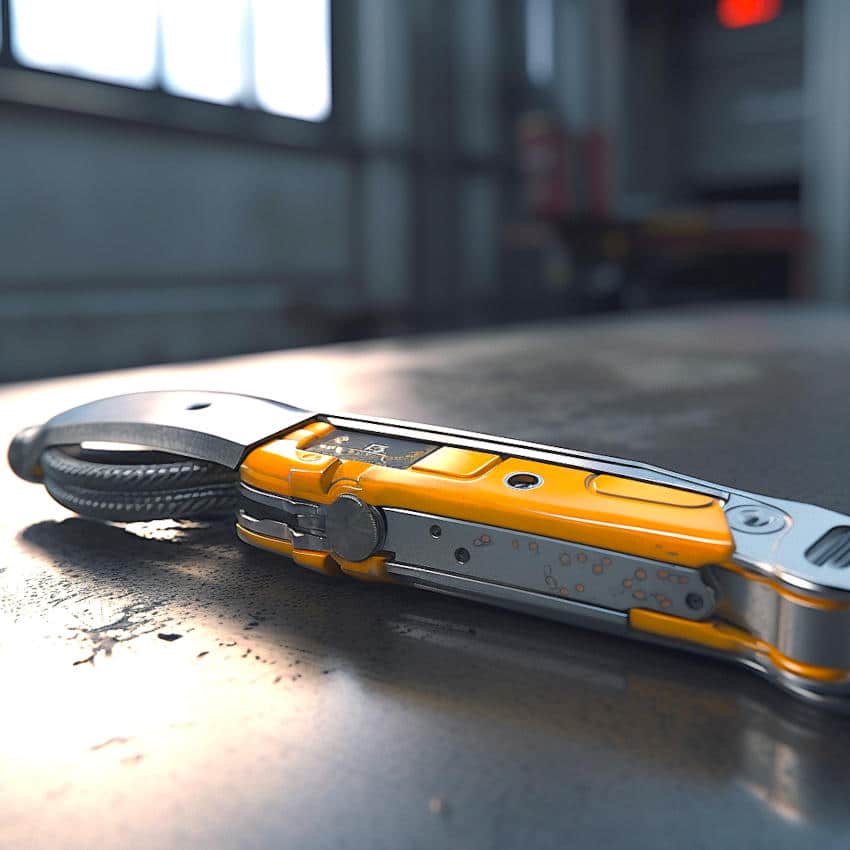
Utility knives are among the most multifunctional tools inside a toolkit. A utility knife, in conjunction with a drywall saw, will assist you in making sharp, straight, and even trim in your sheetrock. They are useful for cutting panels and drilling perforations for switches, washers, and outlets.
Purchasing a knife might appear to be a simple task. It is not difficult, but utility knives differ from one another. Thus, you have to ensure that it is of good quality.
Drywall Saw
A high-quality plasterboard saw would be a must-have when sheetrocking any interior space. Trimming the sheetrock correctly will result in minimal waste and edges that are simple to smooth by applying the joint compound.
Mud Pan
A mud pan is a basic piece of hardware that is often overlooked. Using a mud pan eliminates the need to carry a heavy bucket of joint compound all over your work area. Just put some mud in a mud pan to make it easier to transport throughout rooms and up-and-down ladders.
Mud pans are available in plastic or stainless steel. It is simply a matter of preference of which one to select.
Drywall Panel Lift
Dry panel is indeed heavy, weighing 50 pounds or more. The weight is exacerbated by its size. Even a small sheet (1/2 inch x 4 feet x 8 feet) is difficult to grasp and transport.
This heavy panel can halt your construction process if you perform the task yourself.
If lifting panels is difficult, a panel lift will be a huge help. You can buy one or rent one from your local hardware shop if you prefer not to contain it in your house.
Safety Items
Your safety and health are the most important things when applying dry panel. Its dust could pass into your eyes, nose, and mouth if you are not properly protected.
Gloves protect the hands and are required when using any power tool. Keep ear protection on hand if you need battery-operated or electric screwdrivers or other loud machinery.
Drywall Cost
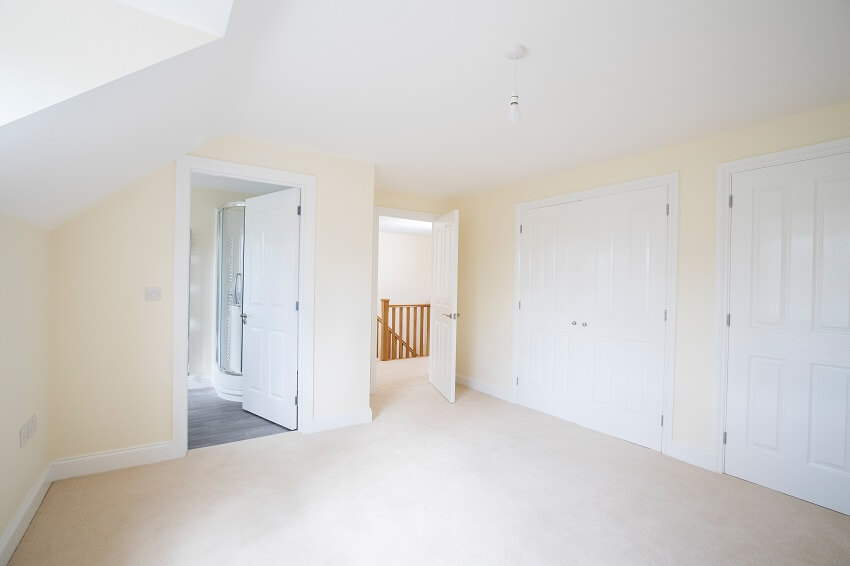
The average cost of drywall and sheetrock is $15 per 4′ x 8′ panel, with prices ranging from $12 to $20 per panel. This equates to a price range of $0.40 to $0.65 per square foot. You can expect to pay $300 to $500 for ceilings and walls in a 200-square-foot space.
Drywall installation costs between $1 and $3 per square foot. Contractors typically charge by the number of hours required for installation, but they may also charge by each panel.
Remember that a fundamental estimate might not include removing or disposing of old plasterboard. You must pay an extra $300 to $500 for such services.
Prices vary depending on the type of board as well. Thicker boards and soundproofing will cost up to $60 per panel. However, here are the other usual costs of several types of drywall and other essential materials needed:
- Green board cost – $14 to $18 per panel
- Blue board cost – $12 to $15 per panel
- Purple board – $15 to $60 per panel
- Gypsum board – $12 to $60 per panel
- Fire-resistant – $20 to $30 per panel
- Sheetrock – $12 to $25 per panel
What Drywall To Use

Drywall for Bathroom
Since bathrooms are persistently in contact with water, it is smart to use moisture or mold-resistant variant.
Such types are made with a denser paper backing than standard variety and are wax-coated for additional moisture resistance. Moisture-resistant ones are often called green drywall, while the purple kind is moisture, mildew, and mold resistant.
Drywall for Garage
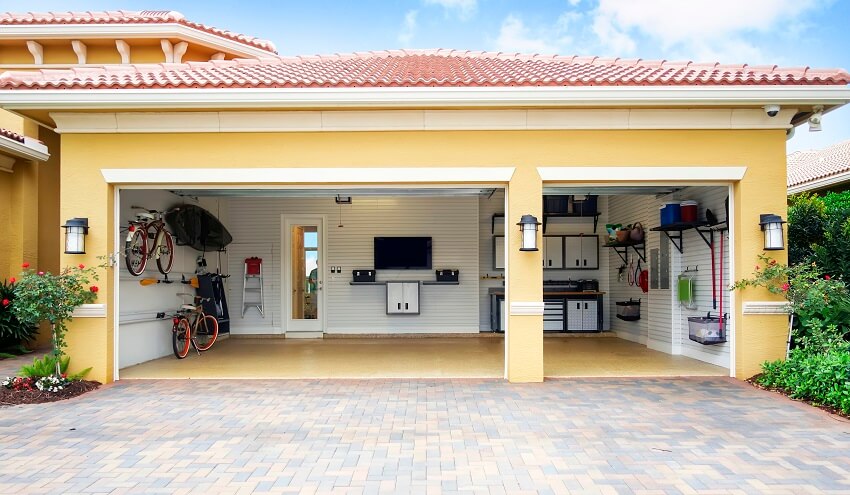
You can use regular 1/2-inch drywall for a large portion of your garage. Use 5/8-inch sheetrock or type X fire-rated panels for the wall and ceiling adjoining the house.
Regular plasterboard sheets can be used for the walls that do not adjoin the house. It does lessen sound and offers an additional surface to hold things on, but it does not provide much waterproofing and can be bothersome in humid weather.
Using 1/2-inch sheetrock saves money and makes installation easier, particularly if you do the process alone.
Fire-resistant or fire-rated and type X drywalls could be a good alternative for your garage, particularly on the wall against your house and the garage ceiling.
It is not totally “fireproof,” but it is composed of specialized non-combustible fibers that help to delay fires. It is thicker and normally thicker than most drywalls. It generally measures 5/8 inch.
Drywall for Ceiling
Fire-resistant panels are mainly used in ceilings to prevent them from falling in the event of a fire.
5/8-inch-thick fire-resistant panels installed on ceilings are less prone to collapsing between the joists than 1/2-inch panels. Incorporating another type of massive surfacing material can exacerbate the weight issue, so 5/8-inch drywall is a better option for ceilings.
“Before repairing the drywall, you must first fix the roof or the plumbing to prevent further damage.” – Myron R. Ferguson, Drywall Professional Techniques for Great Results
Moisture-resistant drywall, also known as purple drywall, has the same benefits as regular ones but is more resistant to moisture and mold. It is also commonly applied in the construction of ceilings. Visit our ceiling texture types guide for more information.
Furthermore, it can be used in all ceiling uses and is excellent for areas that require increased moisture and mold resistance.
Drywall for Basement
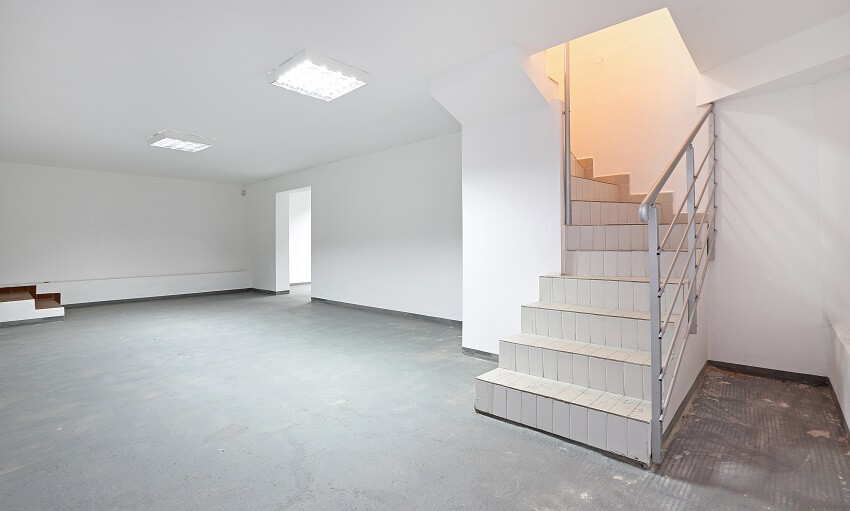
Fire-resistant drywall is often used in basements and around potentially flammable equipment. It includes fiberglass, which decelerates fire spread and does not burn as quickly as standard gypsum.
Type C is more durable than Type X, supplying up to 4 hours of resistance versus X’s 1 hour. Hence, Type C is much more recommended for basements.
3/8-inch regular panels are also well-known in basements and other areas where a specific type of dry panel is not required.
While less costly than thicker panels, unfortunately, it can also also be less durable. For more related articles, visit our guide on the best types of basement wall panels.
What Is The Best Drywall To Use?

Green boards and purple can be the best options if your house or room faces moisture and mold-related issues. Greenboard plasterboard is commonly used in applications where moisture is a concern, such as bathrooms.
The purple type is also impervious to moisture, mold, and mildew. Aside from that, it is resistant to scratches, scuffs, and dents, making it an excellent selection for high-traffic areas.
However, if you wish to put plasterboards in areas with flammable equipment, make sure to install fire-resistant types. Consider installing type C panels to delay the spread of fire more efficiently.
What Type Of Sandpaper For Drywall?
Aluminum oxide sandpaper wears slower and lasts longer, so it’s the best sanding material option. Furthermore, aluminum oxide sandpaper’s surface is denser than garnet paper’s, so it is not easily damaged.
Start by sanding down the joint compound with 120-grit sandpaper. However, you might be urged to use a coarser grit to complete the job faster, but anything coarser than 100-grit will leave noticeable scratch marks in your joint compound.
After you have sanded down your seams, you could go over everything again with 150-grit dry panel sanding paper if you want.
Anything finer than 100-grit will take far too long to get sanded properly. This presumes you are manually sanding with a hand sander or pole sanders.
What Type Of Mud For Drywall?
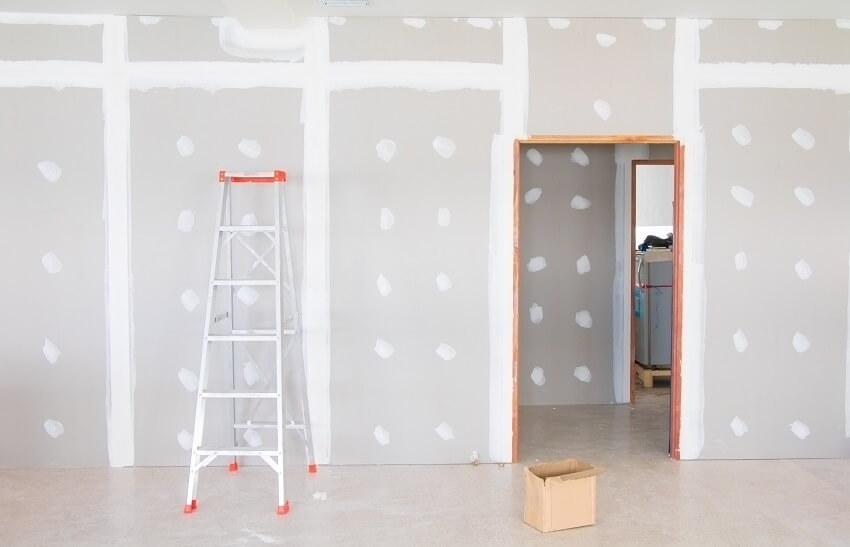
After the two initial coats of taping substance have adhered to a taped joint, you can try to apply the topping compound, as it is the best mud to use. A topping compound is a low-shrinking substance that applies seamlessly and forms a firm bond. It is also very practical to work with.
Moreover, the topping compound is commonly sold as a dry powder that must be mixed with water. This makes it less practical than premixed compounds, but it enables you to mix only what you need.
The remainder of the dry powder can be saved for upcoming usage. Topping compound is also available in pre-mixed containers or pails to buy whatever type.
Are Sheetrock And Drywall The Same?
Dry panel, which also includes sheetrock, is used to construct interior walls in most conventional, contemporary houses nowadays.
On the other hand, sheetrock is a brand name for dry panel encompassing various types in varying thicknesses and lengths.
One of the benefits of sheetrock is that it is subjected to industry-leading quality assurance screening, as opposed to generic brands, which may fall short of certain important measures.
In a nutshell, dry panel can refer to different brands and types, while sheetrock is merely a gypsum board brand. Read more about our sheetrock vs drywall guide for a more in-depth comparison.
Can You Paint Over Drywall?
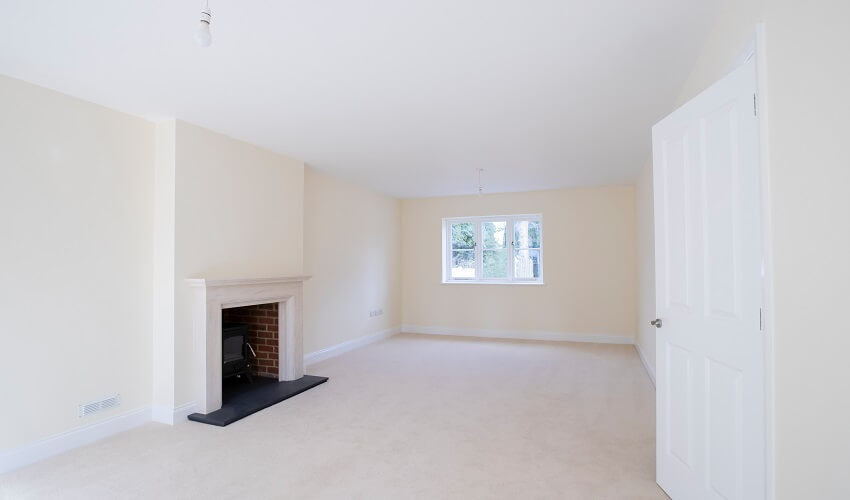
Yes, you can safely paint stucco sheet rock. Nevertheless, it is important to note that freshly mounted dry panel wall should first be treated and prepared to ensure optimum results.
Taping and finishing all seams and priming mud and wallboard are all part of the preparation procedure. Finishing paint can adhere after the project has been finalized and dried. Self-priming wall paint can help to speed up the process and provide greater results.
Consider using a high-quality acrylic latex primer before adding a new coat of paint to previously painted gupsum board. Applying a stain-blocking primer aids in the concealment of marks, blemishes, and other discolorations that could lead to a less-than-perfect finish.
Remember that higher-sheen paints are easier to clean and maintain when selecting a finishing paint. So, if you have young children at home, this information can save you time and effort.
What Goes Over Drywall?
The compound, also known as mud or spackle, is a significant element used to go over plasterboard. After hanging and fastening the plasterboarc to wall framing, you can use a 4-inch-wide utility knife to apply the compound to the board seams.
How Do You Prep Drywall?

Drywall should be primed before being painted or customized to guarantee that the paint and any other elements adhered remain in place and are not impacted by temperature fluctuations in the space or environment.
To prepare your wallboard, clean it by sanding it using high-quality sandpaper, vacuuming it, and wiping it down with a dark cloth to remove any dust. After that, you can start applying primer.
Do You Mud The Entire Drywall?
It could be very inappropriate to mud an entire wall. The edges of the wallboard panels are beveled. Thus, there will be a minor indentation where the sheetrock parts fit together once the panels are assembled.
Aside from filling small gaps and concealing certain flaws, mudding aims to fill these indented segments to generate a flawlessly flat and seamless surface. This implies you will mud a few inches around each joint and over tape and holes, but not the entire panel.
Visit our guide on different wall texture types for more related content.

